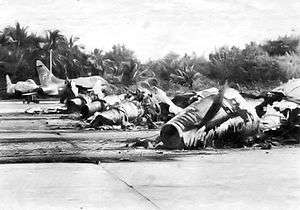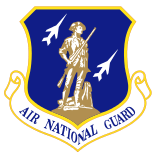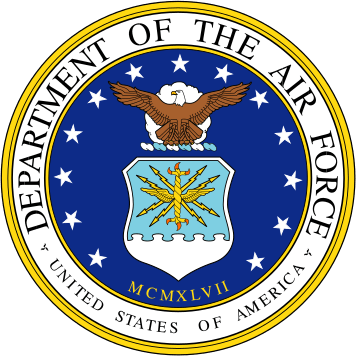Puerto Rico Air National Guard
| Puerto Rico Air National Guard | |
|---|---|
|
198th Airlift Squadron - Lockheed C-130E 64-0510 at Muniz ANGB, San Juan. The 198th is the oldest unit in the Puerto Rico Air National Guard, having over 67 years of service to the state and nation | |
| Active | 23 November 1947 - present |
| Country |
|
| Allegiance |
|
| Branch |
|
| Type | Air National Guard |
| Role | "To meet Commonwealth and federal mission responsibilities." |
| Size | 1,200 airmen[lower-alpha 1] |
| Part of |
Puerto Rico National Guard United States National Guard Bureau |
| Garrison/HQ | Puerto Rico Air National Guard, Muñiz Air National Guard Base, 200 Carr Sector Central Carolina, Puerto Rico 00986 |
| Commanders | |
| Civilian leadership |
President Barack Obama (Commander-in-Chief) Deborah Lee James (Secretary of the Air Force) Governor Alejandro Garcia Padilla (Governor of Puerto Rico) |
| State military leadership | Brigadier General Juan Jose Medina Lamela |
| Insignia | |
| Emblem of the Puerto Rico Air National Guard |
|
| Aircraft flown | |
| Transport | C-130E Hercules |
The Puerto Rico Air National Guard (PR ANG) —Spanish: Guardia Nacional Aérea de Puerto Rico— is the air force militia of the Commonwealth of Puerto Rico, an unincorporated territory of the United States of America. It is, along with the Puerto Rico Army National Guard and the Puerto Rico State Guard, an element of the Puerto Rico National Guard. After beginning as four units, the PRANG expanded to 11 units by the 1980s, including the 1956th Tactics Combat Group, the 140th Radar Squadron and others.[2]
As commonwealth militia units, the units in the Puerto Rico Air National Guard are not in the normal United States Air Force chain of command. They are under the jurisdiction of the Governor of Puerto Rico though the office of the Puerto Rico Adjutant General unless they are federalized by order of the President of the United States. The Puerto Rico Air National Guard is headquartered at San Juan commanded by BG Wayne Zimmet. The 156th Airlift Wing at Muñiz Air National Guard Base, Carolina, and its commander is Col Jose A. (Andy) Sanchez.
Overview
Under the "Total Force" concept, Puerto Rico Air National Guard units are considered to be Air Reserve Components (ARC) of the United States Air Force (USAF). Puerto Rico ANG units are trained and equipped by the Air Force and are operationally gained by a Major Command of the USAF if federalized. In addition, the Puerto Rico Air National Guard forces are assigned to Air Expeditionary Forces and are subject to deployment tasking orders along with their active duty and Air Force Reserve counterparts in their assigned cycle deployment window.
Along with their federal reserve obligations, as commonwealth militia units the elements of the Puerto Rico ANG are subject to being activated by order of the Governor to provide protection of life and property, and preserve peace, order and public safety. Commonwealth missions include disaster relief in times of earthquakes, hurricanes, floods and forest fires, search and rescue, protection of vital public services, and support to civil defense.
Components
The Puerto Rico Air National Guard consists of the following major unit:
- Established 23 November 1947 (as: 198th Fighter Squadron); operates: C-130E Hercules
- Stationed at: Muñiz Air National Guard Base, Carolina
- Gained by: Air Mobility Command
Support Unit Functions and Capabilities:
- 141st Air Control Squadron. - Punta Borinquen Radar Station - Aguadilla (former Ramey AFB)
- During exercises, contingencies, or actual war, the 141st Air Control Squadron's Command and Control mission is to provide meteorological support and deploy with, advise, and assist the ground force commander in planning, requesting, coordinating and controlling close air support, tactical air reconnaissance, and tactical airlift.[3]
- 140th Air Defense Squadron. - Fixed Radar Unit, Punta Salinas - Toa Baja
- The mission of the 140th Air Defense Squadron involves work with a variety of satellites and systems to provide individuals in the field with real-time space situational awareness.[4]
History
The Puerto Rico Air National Guard came into existence as a result of the efforts led by Colonel Mihiel Gilormini also known as "El Gallo de Yauco", Colonel Alberto A. Nido and Lieutenant Colonel José Antonio Muñiz.[5] On October 26, 1947, several officers were sworn as members if the nascent PRANG.[6] On November 23, 1947, 18 officials and 33 national guardsmen were organized as a unit under Cpt. Nido.[7] The unit was assigned to the Isla Grande Airport and received its first combat aircraft of the Republic P-47 Thunderbolt model.[7] The new PRANG was subdivided into four units.[2] The entity was also assigned the 156th Tactical Combat Group, a medical unit.[2] In November 1950, the 198th was activated during the Jayuya Uprising, remaining in action for 11 days in reconnaissance and transporting supplies.[8]
In 1954 the PRANG received its first T-33 planes and the following year it received F-86 jets.[8] Aboard these jets, several members of the 198th's Flying Buccaneers broke the sound barrier, including Col. Alberto Nido, Com. Mihiel Gilormini, First Lt. Peter Kryzanowski and Second Lt. José Bloise.[9] The squadron also became distinguished since several of its members were bilingual, a novelty during these days.[10] In a subsequent inspection of Ramey, a group of eleven generals led by Gen. George Finch of the 14th Air Force, noted the progress of the 198th in five years.[11] Sgt. Eugenio Betancourt and Sgt. Rafael Altieri were decorated during this visit, receiving medals donated by the Legislature if Puerto Rico for outstanding service during the year.[12] In 1956, it was relocated at the Isla Verde Airport.[8]
After serving during the Korean War, José Muñiz was placed in charge of the 198th Combat Squadron, a function that he performed until his death on July 5, 1960.[8] During this year, the PRANG was activated to provide assistance to the government during a series of floods that affected the east coast of Puerto Rico.[13] During the Cuban Missile Crisis, all pilots were placed on alert and waiting for orders while the crisis was solved in the adjacent island.[13] In 1963, the PRANG participated in the search for Mercury Astronaut Scott Carpenter following his first orbital flight, which the 140th Radar Squadron accomplished under Col. Fred Brown.[13] The following year, personnel and supplies were sent to the Dominican Republic in response to the Dominican Civil War.[13]
Beginning in 1964, the unit was assigned the tactical combat and surveillance of the Puerto Rico air space.[7] The 198th Tactical Combat Squadron was placed under Commander Jan Johnson, receiving F-86E, F-86D, F-86H and F-104 models in 1967.[7] This same year, its home base was renamed after Lt. Col. José Muñiz and the PRANG also trained personnel for three groups IOC the Venezuelan Air Force.[8] The entity recruited poor children, hosting a camp for that population in 1970.[2] That same year, the 156th was given an award as the most prominent medical unit in all of the USNG system.[2]
One of P-47 Thunderbolts was restored for flight in 1972.[7] Towards the year's end, the PRANG was sent with supplies for the victims of the 1972 Nicaragua earthquake.[13] In 1974, the unit was sent to Honduras following the passing of Hurricane Fifi–Orlene.[13] The following year, the PRANG was sent to respond to the 1976 Guatemala earthquake.[2] In 1976, the 198th received an A7-D Corsair.[7] In 1976, the unit's double task was modified.[7] By 1977, the same year that the PRANG celebrated its 30th Anniversary, the 140th Radar Squadron was operating additional detachments at Ramey Air Force Base.[14]
Gilormini was promoted to brigadier general and served as commander until his retirement in 1975. Colonel Nido was promoted to Brigadier General and served at National Guard Headquarters as Chief of Staff for Air. Brigadier General Jose M. Portela, the youngest C-141 Starlifter aircraft commander and captain was the only reservist ever to serve as director of mobility forces for Bosnia, served as commander of the Puerto Rico Air National Guard from January 11, 2005 to November 2006.[15]
The tactical aviation element of PRANG operates as the 156th Airlift Wing, 198th Airlift Squadron, flying C-130E aircraft. They operate out of Muñiz Air National Guard Base, which shares the runways with Luiz Muñoz Marín International Airport (SJU, originally San Juan International Airport). In the past, they have operated P-47 Thunderbolts, C-47 Skytrains, C-45, T-6 Texan, B-26 Invader, L-5 Sentinel, T-33 Shooting Star, F-86D, F-86E, and F-86H Sabre Jets, F-104 Starfighters, C-54, T-29, C-131, U-3, O-2, A-7D Corsair II, F-16 Fighting Falcons, C-26, and currently, C-130 Hercules type aircraft. Phasing out the F-16s left Puerto Rico with no air-to-air defense assets.
In August 2016, the 156th was recognized.[16]
Muñiz Air National Guard Base

Muñiz Air National Guard Base or "Base Muñiz" in Carolina, Puerto Rico was formally named in 1963 to honor of one of the initial members of the unit who was killed in the line of duty. Lieutenant Colonel José Antonio Muñiz (full name: José Antonio Muñiz Vazquez) was lost on July 4, 1960 when his F-86D lost power on climbout for a formation fly-by. Major General Orlando Llenza, then a fellow aviator in the unit, later described the loss in the following translation:
We were short one pilot and Joe offered to stand in. I was formation lead. Right after departing the runway, his afterburner nozzles failed open, indicating a loss of power. The ejection seats in use at the time could not safely extract a pilot at low altitude and Joe went in little after takeoff. No one in the flight mentioned the event; we executed the flyover and were notified of the loss upon our return to base. Shortly after that, we received the F-86H which did not use afterburning and could fly non-stop from homestead AFB (in Florida) to San Juan unlike the previous D and E models, which had to stop for fuel at Guantanamo, Cuba. .[17]
Muñiz ANGB is the home of the Puerto Rico Air National Guard's 156th Airlift Wing and the 198th Airlift Squadron.
1981 EPB attack
| 1981 Muñiz Air National Guard Base attack | |
|---|---|
 Destroyed A-7D aircraft of the Puerto Rico Air National Guard destroyed at Muñiz Air National Guard Base, 12 January 1981. | |
| Type | bombings |
| Location | San Juan, Puerto Rico |
| Target | Luis Muñoz Marín International Airport |
| Date | January 12, 1981 early morning |
On 12 January 1981, the Ejército Popular Boricua (Boricua Popular Army), a Puerto Rican separatist organization, carried out multiple bombings at the Muniz Air National Guard Base. At the time, it was the largest attack on U.S. military forces since the Vietnam War. The attack was timed to coincide with the birthday of the Puerto Rican independence advocate Eugenio María de Hostos.[18] The attack incurred approximately $45,000,000 damage to ten A-7D aircraft and a single F-104 by eleven commandos of the Popular Army of Puerto Rico, also known as "The Macheteros." The unit was equipped with eighteen A-7D and one F-104 aircraft.[19]
Eleven saboteurs, disguised in military uniforms, penetrated the security fence and infiltrated the A-7 parking ramp through a hole cut in the perimeter chain link fence. Investigators believe that some, if not all, arrived near the ramp in a boat surreptitiously guided along a nearby channel. The operation occurred during USAF security police (SP) shift changeover. Security was provided by both contracted civilian guards and operations and maintenance-funded, uniformed military, full-time and part-time Air National Guard Security Policemen. The perpetrators exited using the reverse of their entry method. Choosing to strike at shift change indicates the possibility of prior surveillance or insider information. The commandoes placed approximately 25 explosive devices on the aircraft.

The planes were destroyed using individual satchels containing four sticks of Iremite (an emulsion explosive) with detonators and incendiary charges. They were time-delayed using a simple but effective watch and battery combination.[19]
The explosives were stolen from a Puerto Rican explosives factory, with the theft traced to Ejército Popular Boricua. The AFOSI (United States Air Force Office of Special Investigations) called the explosives “sophisticated”. The entire operation took less than eight minutes, and this group of semiskilled intruders was able to inflict severe damage to mission capability.[19]
Press coverage was substantial at the time of the incident, but died down quickly. This was the first peacetime incident in which USAF aircraft were destroyed by a domestic act, and the first time separatists had attacked a USAF installation on US soil. It was greatest material loss from any single attack perpetrated against the USAF anywhere in the world. The National Guard Bureau (NGB) was aware of the shortfalls in security at Muniz and of the threat, yet corrective actions had not been implemented at the time. The bombings resulted in increases in base security. It was revealed that there were to be 22 personnel, up from 11, guarding the base, funded entirely by the federal government, as well as electric devices added to the fence.[19]
Destroyed aircraft were A-7D AF Serial Numbers 70-1050; 72-0189; 72-0219; 72-0221; 72-0222; 73-0994; 73-1005; 74-1748, and 74-1755. The sole F-104, of a Mission Design Series previously flown by the PRANG, was a non-flyable aircraft destined to be a permanent memorial static display.
See also
References
Notes
Citations
- ↑ Vicens, Antonio (2012). "Ponencia Vista de Transición Gubernamental 2012" (PDF) (in Spanish). Retrieved February 27, 2014.
- 1 2 3 4 5 6 Norat 1987, pp. 174
- ↑ http://mobile.goang.com/Unit/141st+Air+Control+Squadron
- ↑ 140th ADS goang.com
- ↑ GlobalSecurity.org: 156th Airlift Wing
- ↑ Norat 1987, pp. 325
- 1 2 3 4 5 6 7 Norat 1987, pp. 171
- 1 2 3 4 5 Norat 1987, pp. 172
- ↑ Norat 1987, pp. 346
- ↑ Norat 1987, pp. 349
- ↑ Norat 1987, pp. 348
- ↑ Norat 1987, pp. 350
- 1 2 3 4 5 6 Norat 1987, pp. 173
- ↑ Norat 1987, pp. 175
- ↑ National Guard Bureau biography of Brigadier General Jose M. Portela
- ↑
- ↑ Why is the PRANG base at SJU called Muñiz?
- ↑ Anderson, Sean and Stephen Sloan. The Historical Dictionary of Terrorism, Scarecrow Press, 2009 ISBN 978-0-8108-5764-3, Pg. 409
- 1 2 3 4 Operation/event name: Sabotage to A-7 Aircraft at Muniz ANGB, PR, Jan 81
Bibliography
- Norat, José Angel (March 27, 1987). Historia y Tradiciones: Guardia Nacional de Puerto Rico - Cinco Centurias... En Guardia. Esmaco Printers.
- Gross, Charles J (1996), The Air National Guard and the American Military Tradition, United States Dept. of Defense, ISBN 0160483026
External links
| Wikimedia Commons has media related to Puerto Rico Air National Guard. |
- Official sites
- Unofficial sites
From GlobalSecurity.org:



